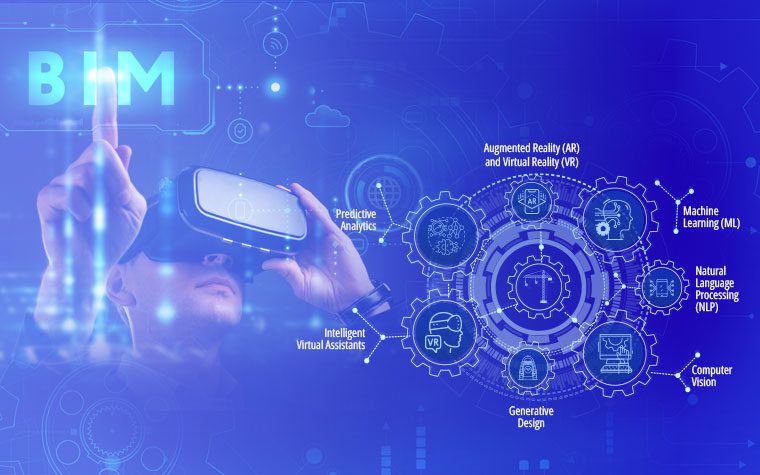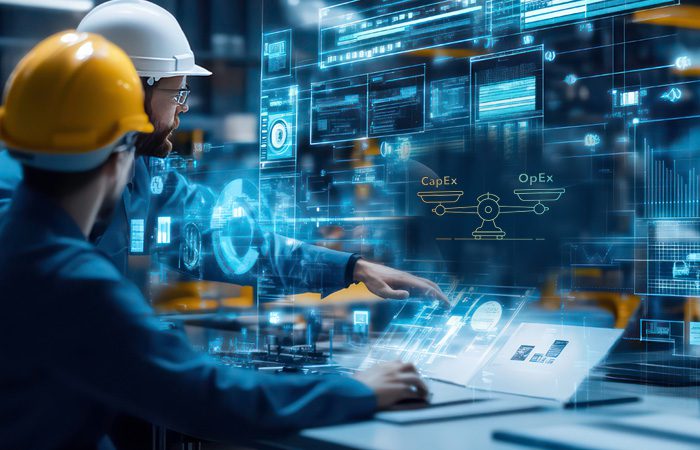
7 Artificial Intelligence Technologies Revolutionizing BIM
Building Information Modeling (BIM), a digital representation of the physical and functional characteristics of a building, serves as a single point of reference and has successfully improved communication and operational efficiency in construction projects. It has now been further enhanced through the integration of cutting-edge AI technologies. Machine learning algorithms and computer vision techniques are employed to analyze vast amounts of data, enabling automated tasks such as object recognition, clash detection, and energy performance analysis.
AI-powered BIM systems optimize design processes, enhance collaboration, and facilitate more efficient decision-making in construction projects. By harnessing the power of AI, BIM is transforming the way buildings are designed, constructed, and managed, leading to improved productivity, cost savings, and sustainability.
Here are the top 7 advanced AI technologies that find extensive application in BIM and show promise for the future as well.
1. Machine Learning (ML)
Machine Learning (ML) has transformed Building Information Modeling by empowering construction projects with enhanced planning, design, and management capabilities. ML algorithms enable BIM systems to extract valuable insights from extensive data collected throughout the project lifecycle. ML techniques optimize project efficiency by improving decision-making and easing up tasks, such as automated clash detection, material quantity estimation, energy analysis, and predicting project timelines or costs. Thus, the integration of ML algorithms in BIM holds immense potential for streamlining construction processes and delivering better-built environments.
2. Natural Language Processing (NLP)
Natural Language Processing (NLP) combined with Artificial Intelligence (AI) has transformed the field of Building Information Modeling (BIM). By leveraging NLP and AI, BIM systems can automate tasks such as extracting key information from project documentation, generating reports, analyzing stakeholder requirements, and improving communication among project participants. This integration enhances the efficiency, accuracy, and collaboration in the construction industry, enabling stakeholders to make better-informed decisions throughout the building lifecycle.
3. Computer Vision
By incorporating Computer Vision techniques into BIM workflows, it becomes possible to extract valuable information from images and videos captured on construction sites or within existing buildings. AI algorithms can detect and identify objects, such as structural elements, equipment, and materials, within the captured data. This automated object recognition can significantly enhance the accuracy and efficiency of BIM data extraction.
Moreover, AI-powered Computer Vision can enable the automatic extraction of geometrical and dimensional information from images, reducing the manual effort required for data entry and measurements. This streamlined process can enhance the overall productivity of construction projects and support decision-making processes.
Furthermore, AI algorithms can be trained to identify potential safety hazards or quality issues by analyzing visual data. This proactive approach allows for timely intervention and corrective measures, leading to improved safety standards and project outcomes.
4. Generative Design
By integrating generative design techniques and AI algorithms into BIM workflows, designers can optimize the creation process, improve efficiency, and explore innovative solutions to complex design problems. By leveraging artificial intelligence, designers can generate numerous design alternatives based on specified criteria and constraints. AI algorithms analyze data, simulate scenarios, and produce optimized designs, improving efficiency and creativity. This technology enables faster exploration of design possibilities and facilitates informed decision-making. Ultimately, AI-driven generative design in BIM empowers designers to create more innovative and sustainable solutions in less time.
5. Intelligent Virtual Assistants
IVAs provide a streamlined and efficient approach to managing construction projects. These virtual assistants can understand natural language, interpreting queries, and performing complex tasks, enhancing collaboration, productivity, and decision-making throughout the BIM lifecycle. With their ability to automate repetitive tasks, extract valuable insights from data, and facilitate communication among project stakeholders, IVAs are transforming the way BIM is utilized, ultimately leading to improved project outcomes and increased efficiency in the construction industry.
6. Predictive Analytics
Predictive Analytics with AI is revolutionizing the field of Building Information Modeling (BIM) by enabling accurate forecasting and data-driven decision-making throughout the construction process. AI-powered predictive analysis in BIM further reduces uncertainties, and improves project outcomes. By analyzing historical data and real-time information, AI algorithms can provide valuable insights that aid in mitigating potential issues and enhancing project efficiency. Moreover, predictive analysis with AI can assist in identifying potential clashes, conflicts, or design issues early in the construction process, enabling timely adjustments and avoiding costly rework. By analyzing data from various sources, including sensors and IoT devices, AI can provide real-time monitoring and predictive maintenance, ensuring optimal performance and reducing downtime, making BIM a truly intelligent and proactive solution for the construction industry.
7. Augmented Reality (AR) and Virtual Reality (VR)
Augmented Reality (AR) and Virtual Reality (VR) have emerged as powerful tools in the field of Building Information Modeling (BIM), enhanced by the integration of Artificial Intelligence (AI). By incorporating AR and VR with AI, BIM technology takes a significant leap forward, enabling architects, engineers, and construction professionals to visualize, simulate, and analyze complex projects in an immersive and intelligent manner. In VR, AI algorithms can generate realistic virtual environments based on BIM data. AI can optimize the rendering process, improving the visual quality and performance of VR simulations. Additionally, AI can analyze user interactions within the VR environment, providing valuable insights into how people interact with building designs and identifying areas for improvement. These technologies enhance collaboration, improve decision-making, and streamline the construction process, ultimately leading to more efficient and sustainable outcomes.
Through the course of a project’s lifespan, these AI technologies will support BIM platforms and workflows by streamlining procedures, automating tedious jobs, enhancing communication, and improving decision-making. It is pertinent that stakeholders invest in these technologies and focus on increased adoption in construction operations to ensure optimum results in terms of safety, costs, time, and sustainability.

